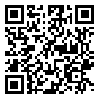1. Krautter U, Mory M, Mogler C, Schmaus M, Zimmermann S, Klemm K, et al. Fatal clostridium septicum infection in a patient with non-hodgkin's lymphoma undergoing multimodal oncologic therapy. Onkologie. 2009;32(3):115–8. [
DOI]
2. Azarbarzin M, Taleghani F, Malekian A. Adolescent made of crystal psychological problems of adolescents who have a parent with cancer- a qualitative research. Medical Science. 2015;25(3):223–29. ]Persian] [
Article]
3. Mahmoodi N, Hoseini Ahangari SA, Zarbakhsh M. Investigating the relationship between parent-child conflict and feeling of loneliness with drug addiction tendency among university students. Islamic Life Style. 2022;6(2):33–40. [Persian] [
Article]
4. McDonald KL, Wang J, Menzer MM, Rubin KH, Booth-LaForce C. Prosocial behavior moderates the effects of aggression on young adolescents' friendships. Int J Dev Sci. 2011;5(1–2):127–37. [
DOI]
5. Kalantar Hormozi A, Kanisanani A. The relationship between adolescents' attitude toward their fathers and loneliness. Counseling Culture and Psychotherapy. 2005;6(23):45–67. [Persian] [
Article]
6. Mousavi SF, Dehshiri G. The predictors of loneliness in adolescents: the role of gender, parenting rearing behaviors, friendship quality, and shyness. Journal of Woman and Family Studies. 2021;9(4):1–20. [Persian] [
Article]
7. Zareei H, Yektafar M, Asadi S. The prediction of internet addiction based on parental affection and social skills, the mediating role of loneliness in ninth grade students in Yazd. Journal of Family Research. 2022;18(1):121–34. [Persian] [
Article]
8. Samaha M, Hawi NS. Relationships among smartphone addiction, stress, academic performance, and satisfaction with life. Comput Human Behav. 2016;57:321-25. [
DOI]
9. Askarizadeh Gh, Poormirazaei M, Hajmohammadi R. Identity processing styles and cell phone addiction: the mediating role of religious coping. J Res Relig Health. 2016);3(1):18–29. [Persian] [
Article]
10. Goswami V, Singh DR. Impact of mobile phone addiction on adolescent's life: a literature review. International Journal of Home Science. 2016;2(9):69–74.
11. Bhardwaj M, Ashok S. Mobile phone addiction and loneliness among teenagers. International Journal of Indian Psychology. 2015;2(3). [
DOI]
12. Li X, Feng X, Xiao W, Zhou H. Loneliness and mobile phone addiction among Chinese college students: the mediating roles of boredom proneness and self-control. Psychol Res Behav Manag. 2021;14:687–94. [
DOI]
13. Wang C, Lee Matthew KO. Why we cannot resist our smartphones: investigating compulsive use of mobile SNS from a stimulus-response-reinforcement perspective. Journal of the Association for Information Systems. 2020;21(1):175–200. [
DOI]
14. Hampton KN. Persistent and pervasive community: new communication technologies and the future of community. American Behavioral Scientist. 2016;60(1):101–24. [
DOI]
15. Yao M, Zhong Z. Loneliness, social contacts and Internet addiction: a crosslagged panel study. Comput Human Behav. 2014;30:164-70. [
DOI]
16. Akbari F, Azizi M, Afraei R. Predicting cell phone addiction based on feelings of loneliness and social anxiety with a gender-modifying role in undergraduate students of Islamic Azad University of Tehran. Journal of Psychology New Ideas. 2022;11(15):1–8. [Persian] [
Article]
17. Cheraghiani F. Predicting mobile phone addiction based on brain-behavioral systems, loneliness, and self-esteem in adolescent girls. Journal of New Advances in Behavioral Sciences. 2021;6(54):639–52. [Persian] [
Article]
18. Bakioğlu F. Internet addiction and social self-efficacy: the mediator role of loneliness. Anales de Psicología. 2020;36(3):435–42. [
DOI]
19. Icekson T, Begerano OD, Levinson M, Savariego J, Margalit M. Learning difficulties and loneliness in college and beyond: the mediating role of self-efficacy, proactive coping, and hope. Int J Environ Res Public Health. 2021;18(19):10508. [
DOI]
20. Darasian Salmasi A, Rezakhani S. The contribution of self-efficacy and sensation-seeking in predicting internet addiction in girls. Women's Studies Sociological and Psychological. 2019;17(3):31–56. [Persian]
21. Heuven E, Bakker AB, Schaufeli WB, Huisman N. The role of self-efficacy in performing emotion work. J Vocat Behav. 2006;69(2):222–35. [
DOI]
22. Lee YK, Chang CT, Cheng ZH, Lin Y. How social anxiety and reduced self-efficacy induce smartphone addiction in materialistic people. Social Science Computer Review. 2018;36(1):36–56. [
DOI]
23. Yang R, Tracy EL, Jensen FB, Jiang Y, Linder L. The effect of screen viewing duration and self-efficacy in limiting screen viewing on loneliness in adolescent-parent dyads: an application of the actor-partner interdependence model. J Pediatr Nurs. 2019;47:106–13. [
DOI]
24. Rana NP, Slade E, Kitching S, Dwivedi YK. The IT way of loafing in class: extending the theory of planned behavior (TPB) to understand students' cyberslacking intentions. Comput Human Behav. 2019;101:114–23. [
DOI]
25. Röttger S, Maier J, Krex-Brinkmann L, Kowalski JT, Krick A, Felfe J, et al. Social cognitive aspects of the participation in workplace health promotion as revealed by the theory of planned behavior. Prev Med. 2017;105:104–8. [
DOI]
26. Cheng PY, Chu MC. Behavioral factors affecting students' intentions to enroll in business ethics courses: a comparison of the theory of planned behavior and social cognitive theory using self-identity as a moderator. J Bus Ethics. 2014;124(1):35–46. [
DOI]
27. Adelman C. Kurt Lewin and the origins of action research. Educational Action Research. 1993;1(1):7–24. [
DOI]
28. Hyun JS, Park CJ, Ha HH. Analysis of gender difference in time perspectives and relationship with self-efficacy about mobile phone addiction of adolescent. The Journal of the Korea Contents Association. 2013;13(6):412–24. [
DOI]
29. Ezoe S, Toda M. Relationships of loneliness and mobile phone dependence with Internet addiction in Japanese medical students. Open Journal of Preventive Medicine. 2013;3(6):407–12. [
DOI]
30. Sun R, Gao Q, Xiang Y, Chen T, Liu T, Chen Q. Parent–child relationships and mobile phone addiction tendency among Chinese adolescents: the mediating role of psychological needs satisfaction and the moderating role of peer relationships. Child Youth Serv Rev. 2020;116:105113. [
DOI]
31. Palent J. SPSS. Kakavand A. (Persian translator). Karaj: Sarafraz publication; 2013. [Persian]
32. Sevari K. Construction and validation of the mobile phone addiction questionnaire. Quarterly of Educational Measurement. 2014;5(15):126–14. [Persian] [
Article]
33. Russell D, Peplau LA, Cutrona CE. The revised UCLA Loneliness Scale: concurrent and discriminant validity evidence. J Pers Soc Psychol. 1980;39(3):472–80. [
DOI]
34. Zarei S, Memari AH, Moshayedi P, Shayestehfar M. Validity and reliability of the UCLA Loneliness Scale version 3 in Farsi. Educational Gerontology. 2016;42(1):49-57. [
DOI]
35. Sherer M, Maddux JE. The Self-Efficacy Scale: construction and validation. Psychol Rep. 1982;51(2):663-71. [
DOI]
36. Asgharnezhad T, Ahmadi Deh Ghotbeddini M, Farzad V, Khodapanahi MK. Study of psychometric properties of the general self-efficacy scale. Journal of Psychology. 2006;10(3):262–74. [Persian]
37. Fine MA, Worley SM, Schwebel AI. The parent-child relationship survey: An examination of its psychometric properties. Psychological Reports. 1985;57(1):155–61. [
DOI]
38. Araghi Y. Comparison of the quality of parent- child relationship of two groups of aggressive and non aggressive boy students. Psychological Studies. 2009;4(4):113–29. [Persian] [
DOI]
39. Ataee Far R, Amiri S. An exploration of the association between effective spousal communication and parent-child relationship. Journal of Family and Research. 2016;13(1):7–38. Persian] [
Article]
40. Jahng KE. Maternal abusive parenting and young South Korean adolescents' problematic smartphone use: the moderating effects of time spent hanging out with peers and trusting peer relationships. Child Youth Serv Rev. 2019;98:96–104. [
DOI]
41. Liu CY, Kuo FY. A study of internet addiction through the lens of the interpersonal theory. Cyberpsychol Behav. 2007;10:799–804. [
Article]
42. Qiao L, Liu Q. The effect of technoference in parent-child relationships on adolescent smartphone addiction: the role of cognitive factors. Child Youth Serv Rev. 2020;118:105340. [
DOI]

 ، علبرضا کاکاوند*2
، علبرضا کاکاوند*2 
 ، مهدی احمدی1
، مهدی احمدی1 
 ، علی محمدی بنمار1
، علی محمدی بنمار1 




